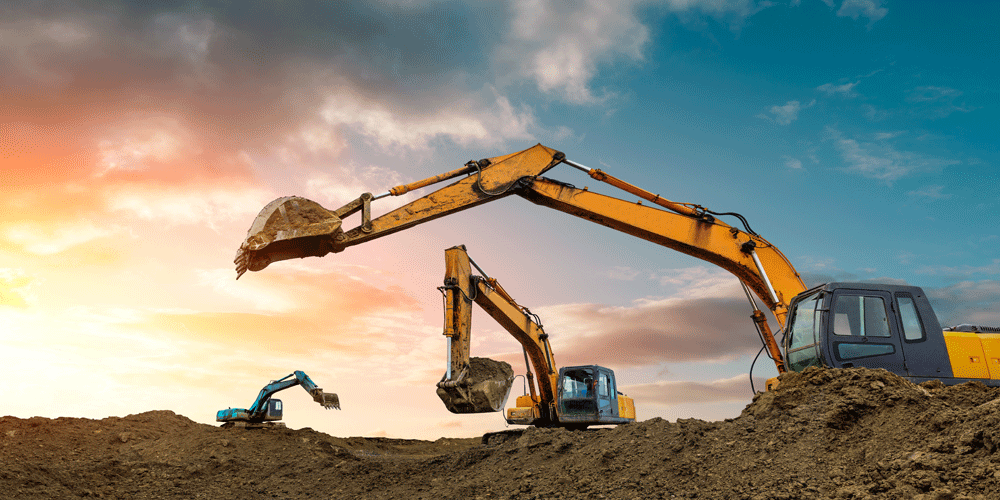Quick Guide to the Types of Equipment Typically Used in a Construction Project
Construction projects involve a wide range of tasks, from excavation and grading to structural assembly and finishing. To successfully execute these projects, various types of equipment are utilised to improve efficiency, safety, and productivity. In this article, we will explore the essential equipment commonly employed in construction projects.
Earthmoving Equipment:
Earthmoving equipment is used for various tasks involving the movement and excavation of earth and materials. Some commonly used earthmoving equipment includes:
a) Excavators: These versatile machines are equipped with buckets and hydraulic arms for digging trenches, foundations, and excavating large quantities of soil.
b) Backhoe Loaders: Combining the capabilities of a loader and an excavator, backhoe loaders are ideal for digging, loading, and material handling tasks.
c) Bulldosers: Designed for heavy-duty earthmoving, bulldosers are equipped with a large blade at the front for pushing and leveling soil, debris, and other materials.
d) Graders: Graders are used for fine grading and leveling of surfaces, such as roads and foundations. They ensure precise grading and surface finishing.
Lifting and Material Handling Equipment:
These types of equipment are used in many Construction Projects and are essential for lifting, moving, and transporting heavy materials and equipment around the construction site. Key examples include:
a) Cranes: Tower cranes, mobile cranes, and crawler cranes are used to lift and transport heavy loads to different heights and locations within the construction site.
b) Forklifts: Forklifts are utilised for moving and lifting heavy pallets, equipment, and materials over short distances. They are commonly found in warehouses and construction sites.
c) Conveyor Systems: Conveyor belts and systems help in the efficient transportation of bulk materials, such as sand, gravel, and concrete, over long distances.
Concrete and Asphalt Equipment:
Construction projects often involve the use of concrete and asphalt for various applications. The following equipment is commonly used for mixing, transporting, and placing these materials:
a) Concrete Mixers: Concrete mixers are used to combine cement, aggregates, and water to create a homogeneous mixture that can be easily poured and shaped.
b) Concrete Pumps: These machines are used to transport and pump liquid concrete from the mixing site to the desired location, especially for high-rise construction projects.
c) Asphalt Pavers: Asphalt pavers are used for the laying and compacting of asphalt on roads, parking lots, and other surfaces.
Power Tools and Small Equipment:
Numerous power tools and small equipment are utilised for various construction tasks, such as cutting, drilling, fastening, and finishing. Examples include:
a) Power Drills: Essential for drilling holes and driving screws, power drills come in various sises and types, including cordless options.
b) Circular Saws: Circular saws are used for cutting different materials, such as wood, metal, and plastic, during construction projects.
c) Nail Guns: Nail guns are powerful tools that help in rapid and efficient fastening of materials, such as wood or drywall.
d) Concrete Vibrators: These tools are used to eliminate air bubbles and ensure proper compaction of freshly poured concrete.
Scaffolding and Access Equipment:
Scaffolding and access equipment are crucial for providing a safe working environment and facilitating access to elevated areas. These include:
a) Scaffolding Systems: Scaffolding provides temporary platforms and support structures for workers to perform tasks at heights. It ensures stability and safety during construction, maintenance, and repairs.
b) Aerial Work Platforms: Aerial work platforms, such as scissor lifts and boom lifts, allow workers to access elevated areas safely. They are used for tasks like painting, installation, and maintenance.
c) Ladders and Stairs: Ladders and stairs are essential for accessing different levels of a construction site. They come in various sises and materials to suit different project requirements.
Compaction Equipment:
Compaction equipment is used to compress and consolidate soil, aggregate, and other materials to achieve proper density and stability. Commonly used compaction equipment includes:
a) Plate Compactors: Plate compactors are used for compacting granular soils, asphalt, and paving stones. They provide high-frequency vibration to achieve optimal compaction.
b) Rollers: Rollers are heavy machines equipped with large drums used for compacting soil, asphalt, and other surfaces. They come in different types, such as smooth drum rollers and padfoot rollers.
Demolition Equipment:
Demolition equipment is employed to dismantle and remove existing structures or parts of a construction site. Key demolition equipment includes:
a) Excavators with Demolition Attachments: Excavators equipped with demolition attachments, such as shears or hydraulic breakers, are used to demolish structures, break concrete, and remove debris.
b) Wrecking Balls: Wrecking balls are heavy steel balls suspended from cranes. They are swung into structures to break them down during demolition.
Surveying and Measurement Equipment:
Surveying and measurement equipment is used to gather accurate data about the construction site, including topography, dimensions, and alignment. This equipment includes:
a) Total Stations: Total stations are optical instruments used for precise distance and angle measurements. They are commonly used in land surveying and construction layout.
b) Laser Levels: Laser levels emit a laser beam that serves as a reference for establishing level and straight lines during construction activities.
c) GPS Systems: Global Positioning System (GPS) equipment is used for accurate positioning, navigation, and mapping of construction sites. It provides precise coordinates and facilitates site planning.
These are just a few additional examples of the heavy plant equipment often used in construction projects. The construction industry relies on a wide range of specialised tools and machinery to meet the diverse needs of each project, ensuring efficiency, accuracy, and safety at every stage.
